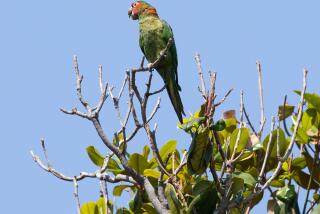Hawaii Keeps Beagle Eye on Hitchhiking Foreign Species
- Share via
HONOLULU — Several times a day, Buster, Gypsy, Milo and Jojo turn out of their kennels at Honolulu International Airport to sniff their way through tons of luggage and air cargo arriving from Guam.
The beagle patrol is charged with keeping unwanted species of animals, insects, plants and fruits from taking up residence in the Hawaiian Islands.
Hawaii already is the endangered species capital of the United States, and air traffic with America and the Far East puts the islands at greater risk for alien species that threaten the survival of the native ecosystem.
The most unwanted alien in snake-free Hawaii is the brown tree snake, a 10-footer that already has devastated Guam’s native bird populations.
Most of the plants and animals isolated here during millions of years of evolution no longer have the survival mechanisms developed by relatives in more hostile environments.
Native animals are easy prey for more aggressive aliens. Native plants lose the competition for water, sunlight and space with pushy newcomers.
“When you take into account Hawaii’s role as a commercial hub in the Pacific, alien pests have thousands of opportunities to reach Hawaii each day via planes, ships, luggage, cargo and mail,” said Rex Johnson, executive director of the Nature Conservancy of Hawaii. “In fact, a new pest reaches Hawaii an average of once every 18 days.”
Hawaii is home to more than one-third of all the endangered and threatened plants, birds and animals in the United States.
Of 140 bird species known to have existed in Hawaii, just 70 survive. And of those, 30 are considered endangered, with a dozen on the brink of extinction.
Ninety-six species of native Hawaiian plants are down to 100 individuals. Six species are down to just one.
“Each time we lose another Hawaiian plant or bird or insect or forest, we lose a living part of our ancient culture,” said Nainoa Thompson of the Polynesian Voyaging Society.
The Nature Conservancy of Hawaii said in 1992 that more than $25 million was spent keeping alien species from entering and leaving Hawaii.
Not all of Hawaii’s efforts have been successful.
Early this century, sugar growers imported mongoose to eat destructive cane field rats. But the predator hunted during the day while the nocturnal prey slept in its burrows. So the mongoose ate ground-nesting birds and poultry.
Some of the more destructive alien species in Hawaii are:
* The Formosan ground termite, which costs Hawaii homeowners and businesses $150 million a year.
* Miconia, a large-leafed plant that, in the wild, grows into a sun-blocking tree, killing the ground cover vital for many native species. It is nicknamed the “green cancer.”
* The banana poka vine, which enshrouds an estimated 70,000 acres in prime native forests.
Guam’s notorious brown tree snake gets the most attention. The greenish-brown reptiles hunt at night and spend most of their time in treetops.
Accomplished hitchhikers, they can slither into any available cargo nook or cranny. Eight have reached Hawaii over the last several years.
Most were dead on arrival, but one may have slipped away at Hickam Air Force Base in 1997. So far, no others are known to have taken up residence here.
Wildlife officials say it would take only one pregnant female laying up to 12 eggs to launch a final ecological disaster for Hawaii’s native birds.
Some scientists believe Guam’s infestation began after World War II when a pregnant snake slithered into some military cargo departing New Guinea. Now some Guam forests contain about 12,000 snakes per square mile, perhaps the highest density of snakes in the world.
On Guam--a U.S. territory about 3,700 miles southwest of Hawaii--about $290,000 is spent fighting the tree snake. Fourteen canine teams inspect all departing aircraft and cargo, sniffing out a dozen snakes a year. Traps kill 7,000 snakes annually.
The venomous tree snake has gobbled nine of Guam’s 11 native land bird species into extinction, short-circuited electrical transformers, bitten hundreds of people and even swiped hamburgers off a grill.
That’s the last thing Hawaii’s $11-billion tourism industry needs.
“One of the greatest unsung advantages we have as a visitor destination is all the things we don’t have--snakes, biting flies, tropical diseases,” said Paul Casey, president of Hawaiian Airlines.
At Hawaii’s airport cargo hold, Buster sniffs a box, then sits and looks at inspector Lisa Nakayama to tell her he found an alien. He is rewarded during this training session with a biscuit.
“He can’t tell us whether it’s a snake or an orange, but it’s something he’s been trained to find,” Nakayama said.
More to Read
Sign up for Essential California
The most important California stories and recommendations in your inbox every morning.
You may occasionally receive promotional content from the Los Angeles Times.













